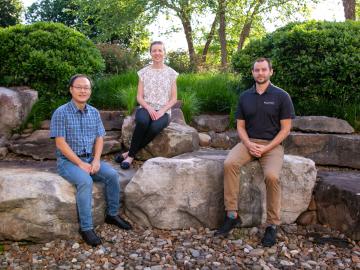Filter News
Area of Research
- (-) Fusion and Fission (15)
- (-) Neutron Science (14)
- Advanced Manufacturing (2)
- Biology and Environment (52)
- Biology and Soft Matter (1)
- Building Technologies (2)
- Clean Energy (49)
- Computational Biology (1)
- Computer Science (1)
- Electricity and Smart Grid (1)
- Functional Materials for Energy (2)
- Isotopes (3)
- Materials (43)
- Materials for Computing (6)
- National Security (25)
- Renewable Energy (1)
- Supercomputing (39)
News Topics
- Advanced Reactors (1)
- Artificial Intelligence (2)
- Biology (2)
- Computer Science (1)
- Cybersecurity (1)
- Decarbonization (2)
- Energy Storage (4)
- Environment (2)
- Fossil Energy (1)
- Frontier (1)
- Fusion (6)
- Grid (1)
- ITER (2)
- Materials (3)
- Materials Science (3)
- National Security (1)
- Neutron Science (10)
- Nuclear Energy (8)
- Partnerships (1)
- Physics (2)
- Quantum Science (1)
- Security (1)
- Space Exploration (1)
- Summit (1)
- Sustainable Energy (3)
- Transportation (1)
Media Contacts

Oak Ridge National Laboratory physicist Elizabeth “Libby” Johnson (1921-1996), one of the world’s first nuclear reactor operators, standardized the field of criticality safety with peers from ORNL and Los Alamos National Laboratory.

Oak Ridge National Laboratory researchers are developing a first-of-its-kind artificial intelligence device for neutron scattering called Hyperspectral Computed Tomography, or HyperCT.

Scientists at ORNL used neutron scattering to determine whether a specific material’s atomic structure could host a novel state of matter called a spiral spin liquid.

Steven Arndt, distinguished R&D staff member in the Nuclear Energy and Fuel Cycle Division at ORNL, began a one-year term on June 16 as the 68th President of the American Nuclear Society.

To solve a long-standing puzzle about how long a neutron can “live” outside an atomic nucleus, physicists entertained a wild but testable theory positing the existence of a right-handed version of our left-handed universe.

The Department of Energy’s Office of Science has selected three Oak Ridge National Laboratory scientists for Early Career Research Program awards.

Practical fusion energy is not just a dream at ORNL. Experts in fusion and material science are working together to develop solutions that will make a fusion pilot plant — and ultimately carbon-free, abundant fusion electricity — possible.

Friederike (Rike) Bostelmann, who began her career in Germany, chose to come to ORNL to become part of the Lab’s efforts to shape the future of nuclear energy.

To achieve practical energy from fusion, extreme heat from the fusion system “blanket” component must be extracted safely and efficiently. ORNL fusion experts are exploring how tiny 3D-printed obstacles placed inside the narrow pipes of a custom-made cooling system could be a solution for removing heat from the blanket.

ORNL researchers used the nation’s fastest supercomputer to map the molecular vibrations of an important but little-studied uranium compound produced during the nuclear fuel cycle for results that could lead to a cleaner, safer world.




